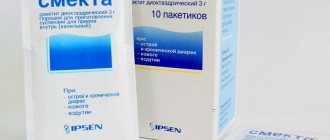What kind of stool is considered normal?
The first days after birth, the baby's stool is normally dark green, almost black meconium. By the third day, the stool will lighten and by the fifth day it will look like a typical breastfed baby's stool.
Normal infant stool is yellowish, straw-colored, yellow-brown or yellow-greenish, the consistency is mushy or in the form of a thin slurry, with a faint sourish odor. Breastfeeding stool cannot be the same color and consistency all the time, because the composition of breast milk changes depending on the duration of lactation and the foods that the mother eats. Often small whitish particles that resemble seeds can be seen in the stool. This is also normal, don't be alarmed.
In a bottle-fed baby, the stool takes on an ointment-like or pasty consistency. Sometimes it becomes formed, with a pungent odor.
The child grows, and the contents of the diaper change with him. After the introduction of complementary foods, the baby’s stool normally acquires a more unpleasant odor and may be ointment-like or shaped. A child’s stool at the “common table” is normally shaped like an adult’s, brown in color with a characteristic odor. The baby has grown up!
Causes of green feces in artificial babies
Green stool in bottle-fed babies is much more common than in breast-fed babies.
This is all explained by the production technology of adapted milk formulas. Typically these mixtures come with partial or complete hydrolysis of cow's milk protein. This is done in order to avoid allergic reactions in children of the first year of life. All this contributes to the fact that the child’s stool may acquire a gray-green tint. Also, mixtures enriched with iron can provoke a change in the color of feces to green. If this is the only symptom that worries parents, and there is no temperature or other impurities in the stool such as mucus or blood, then there is no need to worry. This may be a period of adaptation to the formula, and over time this phenomenon will disappear, and the baby’s stool will acquire a normal color.
Mixed-fed babies may also have signs of greenish stool.
A mother who cares about the health of her child should pay attention to all additional factors that accompany the appearance of green stool. To distinguish normality from pathology, it is important to consider the following points:
- consistency of stool;
- inclusions and impurities in feces;
- presence of additional symptoms;
- child's age.
Red spots in a child's stool may be normal. The capillaries of the intestinal mucosa are still thin and brittle; when the baby strains, they can be damaged, which leads to the appearance of stool streaked with blood.
But if there are a lot of such impurities, this may indicate the presence of infections, internal damage to the intestines, congenital anomalies of the digestive system, acute inflammatory process, especially if the color of the stool is green and there is a strong unpleasant odor.
How often should a child go to the toilet?
For the first 1.5-2 months, a baby on breastfeeding soils his diaper on average 2-6 times a day. But sometimes it happens that a child walks only once every 3-5 days. If at the same time he feels well, gains weight, his stools are of a soft consistency and normal color, then there is no reason to worry and to prescribe treatment. The fact is that in infants, in most cases, functional stool retention occurs. This is due to the immaturity of the child’s gastrointestinal tract and is not a disease.
A bottle-fed child pleases his parents with his exploits less often than a baby - 1-2 times a day. For children over one year old, it is normal to go to the potty 1-2 times a day or every other day. Depending on the diet and individual characteristics of the child’s body, the number of trips to the toilet can be from 3-4 times a week to 3-4 times a day. As a rule, every mother knows what kind of stool is normal for a child.
If you notice something unusual in a diaper or potty, you should be wary.
Green stool in a baby is a physiological norm
First, let's look at situations where a change in stool color is a normal or transitional state of a child.
So:
- meconium (original feces) has a green-brown color in the first days after birth, then it gradually becomes yellow or orange;
- with physiological jaundice, bilirubin is excreted through the intestines, which is why the sclera is yellow and the stool is green with physiological or prolonged jaundice;
- with functional fermentopathy during the transition period and gradual maturation of the digestive tract;
- in case of errors in the mother’s diet.
It should be noted that after birth, various changes occur in the baby’s body - gradual maturation and the beginning of the functioning of the digestive system.
Therefore, during the first month of life, various functional failures and borderline states occur, which completely disappear as the baby grows and adapts to new living conditions.
Green meconium is normal
After the newborn is first applied to the breast, all organs of the baby’s digestive system begin to work, and a few hours after the first feeding, the first bowel movement begins. And the original feces - meconium - are excreted from the intestines. These are metabolic products accumulated in the intestines of crumbs during the period of intrauterine development and exfoliated epithelial cells. It has a green or green-brown color.
This is normal and mom should not worry or worry. After a few days, the color of the stool will change and become yellow or orange.
Physiological jaundice and change in stool color
Another condition of a newborn in which the color of stool changes is physiological jaundice.
Due to the breakdown of fetal hemoglobin, excess bilirubin accumulates in the blood, which is converted into stercobilin in the intestines and turns the stool green.
In addition, in babies with prolonged jaundice, a change in the activity of peristalsis may be observed and the green color of the stool appears longer due to its parietal accumulation.
Therefore, if icteric staining of the sclera and skin is observed for more than 2 weeks, it is necessary to determine the levels of bilirubin in the blood and stimulate its neutralization in the liver and excretion in feces and urine.
Functional fermentopathy
The digestive tract, like other systems of the baby’s body, is characterized by immaturity.
With the gradual differentiation of the gastrointestinal tract and its maturation, many symptoms that worry parents are eliminated:
- periodic intestinal colic as a result of intestinal bloating;
- the baby's anxiety decreases;
- Periodic stool retention and regurgitation disappear.
All these problems are associated with functional enzymopathy (enzyme deficiency), which is combined with relative or so-called “false” lactase deficiency. This condition occurs due to excess lactase (milk sugar) in the foremilk, which the baby consumes with the first portions of breast milk.
This functional failure can also be considered a variant of the norm if the baby does not have signs of inflammation and prolonged manifestations of this dysfunction (other pathological symptoms except green stool).
Relative lactase deficiency is manifested by the periodic appearance of green matter in the stool and whitish undigested lumps.
It is important to remember that if these manifestations drag on and provoke disturbances in the child’s well-being, this may be a sign of true lactase intolerance or dysbacteriosis.
It is necessary to contact a specialist to prescribe examinations and medications:
- enzymes;
- probiotics;
- means to eliminate the accumulation of gases in the intestines.
All these conditions gradually disappear or significantly decrease after one month of age - the color of the stool normalizes and becomes yellow, but sometimes greenish inclusions may appear if the mother’s diet contains greens, fruits (usually apples) or green vegetables (zucchini, squash, cucumbers, Peking cabbage).
When the diet is normalized and balanced, these changes quickly pass and do not affect the baby’s digestion.
LIQUID STOOL
Loose and frequent stools (10 or more times a day) are a reason to consult a doctor.
Diarrhea can be caused by viral and bacterial intestinal infections, poisoning, medications such as antibiotics, poor diet, and even stress. The main danger of diarrhea is dehydration. Therefore, before examining a doctor, you should replace the loss of water and salts. Pharmacies have a large selection of special powders that are dissolved in water and given to the child 5-10 ml every 5-10 minutes.
STOOL WITH UNDIGESTED FOOD PARTICLES
Particles of food in the stool can be associated with overeating, insufficient chewing of food, feeding foods inappropriate for age, etc. In case of digestive disorders, in addition to pieces of undigested food, the stool may become more liquid with the addition of mucus. If the stool changes suddenly, something bothers the child, or other symptoms appear, you need to consult a doctor.
It’s another matter if you see undigested food particles in the stool during the period of introducing complementary foods. Parents should not worry about this, since the intestines are still immature, they are growing and developing, which means they are simply not able to digest the amount of food that comes to them. If there are no other manifestations (diarrhea, constipation, blood or mucus in the stool), you can simply observe.
Pathological conditions of the baby
Let's look in more detail at when green stool is a consequence of the baby's illness.
Dysbacteriosis
Despite the fact that dysbiosis is not considered a disease in our country and throughout the world, it brings a lot of concern to children and their parents.
Dysbacteriosis is a violation of the quantitative ratio (balance) of normal and pathogenic intestinal microflora. This condition is considered not as a disease, but as a set of symptoms that are a consequence of some pathology.
Intestinal dysbiosis is often diagnosed in infants, since the child’s intestines are populated with microflora only after birth, and before that it was absolutely sterile.
Thus, it is very important during this postpartum stage to provide all the conditions for populating the baby’s intestines with beneficial microflora. This is facilitated, for example, by early breastfeeding, natural breastfeeding, and avoiding the use of antibacterial drugs.
And if at this stage, according to certain indications, it is impossible to meet the necessary conditions, then the process of colonization of the intestines with normal microflora is disrupted. Even already populated beneficial microflora may die, and the growth of more resistant pathogenic flora increases. For example, if a nursing mother is forced to treat a bacterial process with antibiotics, then they will have a detrimental effect on the beneficial intestinal microflora of both the child and the mother.
An imbalanced intestinal microflora leads to disruption of digestion, intestinal peristalsis (motor function), and disruption of the synthesis of vitamins and amino acids. The child’s immunity also decreases, since normal microflora is involved in the synthesis of immune cells.
Impaired digestion leads to changes in the qualitative and quantitative composition of feces. With dysbacteriosis, the color of the stool changes (more often the color becomes green), consistency, mucus impurities appear, and the frequency of bowel movements changes (constipation or diarrhea).
Intestinal infection
Intestinal infection in the acute period is manifested by weakness, lethargy of the child, loss of appetite, fever, vomiting, bloating, stool with greens, mucus, possibly blood (with salmonellosis) and a pungent odor. The causative agents of intestinal infection can be:
- viruses,
- bacteria,
- fungal infection,
- their combination.
Viral infection
Due to the immaturity of their immune system, infants are susceptible to various infectious diseases. Common childhood infections such as rotavirus and enterovirus can affect both the upper respiratory tract and the intestines.
All intestinal infections for infants are dangerous, first of all, due to rapid dehydration of the body. Therefore, if you notice in your child:
- temperature,
- profuse regurgitation,
- vomiting
- frequent loose stools,
- loss of appetite,
- rumbling in the stomach,
Useful: Alcoholic drinks while breastfeeding, should you drink or not drink?
It is important to immediately seek medical help and continue to give your baby plenty of fluids.
Lactase deficiency
Lactase deficiency manifests itself as foamy, copious green stools with a sour odor that irritates the skin around the anus. The reason for such changes in the baby is a lack of the enzyme (lactase) that breaks down milk sugar (lactose). This can be either a genetically determined pathology or acquired with age.
There is also such a thing as secondary lactase deficiency. Its manifestations do not differ from those described above. Secondary lactase deficiency occurs more often after an intestinal infection. This is when there is a disruption in the formation of enzymes after an inflammatory process in the intestines. The restoration of the enzyme-forming function occurs gradually and for quite a long time - over several months.
Celiac disease
Celiac disease is a chronic disease characterized by intolerance to the cereal protein gluten. With this disease, the cells of the intestinal wall are affected, and the absorption process in the intestine is disrupted.
Clear symptoms of this disease can only be seen with the introduction of grain-based complementary foods to an infant (cereal porridge, bread, flour products). Celiac disease manifests itself as a dull pain in the abdomen, foul-smelling, profuse yellow-gray or gray-green feces with a sheen, which is caused by the high fat content in the stool. Feces are poorly washed from clothes and washed off the walls of the pot.
Also, such children are characterized by growth retardation, underweight, a sharp increase in abdominal size, capricious behavior and irritability. There is also a delay in teething and various manifestations of deficiency of vitamins and microelements due to impaired absorption (rickets, stomatitis, seizures in the corners of the mouth, anemia).
HARD Lump
Increased density of stools can be observed when a child does not go to the toilet for a long time. One-time stool retention occurs in every child. For example, a child begins to attend kindergarten and holds back stool due to unusual conditions. Feces accumulate in the lower intestine, in the anus, and form a dense lump. This may cause constipation.
Criteria for constipation according to an international group of experts:
1. If the child does not go to the toilet 25% of the time longer than usual.
2. If the child walks less than 2 times a week.
3. If the child has to push excessively.
4. If the stool is too hard or lumpy.
If a child is constipated, the first thing you need to do is adjust your diet and establish a drinking regime. If constipation continues, it is important to see a doctor.
FAT, SHINY STOOL
Fatty stools are associated with impaired absorption of fats and can occur with diarrhea and constipation. In some cases, this happens due to functional immaturity of the intestines, but only a doctor can determine this. Fatty stools can also be a symptom of diseases of the pancreas, as well as the liver and biliary tract. Therefore, if you find such stool in a child, do not hesitate, consult a doctor.
Diagnostics
If there is green stool in combination with other unpleasant symptoms, the baby will undergo standard tests. In addition, scatology is recommended. The study examines the physical and chemical properties of feces. This diagnostic method will help determine the cause of the change in its color.
If necessary, a dysbacteriosis test is prescribed. This will allow you to assess the composition of the intestinal microflora and detect violations. If there is a problem, the specialist will recommend a diet and prescribe medications that restore the balance of microflora.
If inflammatory processes in the intestines are suspected, flora culture and bacteriological analysis will be recommended. After diagnostic tests, the doctor will prescribe a course of therapy, if necessary.
- Loose stools in a breastfed baby
- Loose stools in a breastfed baby
- Why does liquid green stool occur in an adult and how to deal with it? Green loose stool in an adult
- Stomach pain and diarrhea: what to do
STOOL WITH STRONG PUNCTIVE ODOR
An unpleasant odor is, in principle, the norm for children's stool; even children do not poop with lilies of the valley. But some features of the smell should alert parents and become a reason to contact a pediatrician. For example, a hydrogen sulfide smell indicates viral, bacterial infections or intestinal diseases. With lactase deficiency, the stool smells very sour and pungent. In this case, along with the smell, the consistency of the stool usually changes; most often the smell is a secondary manifestation of some kind of digestive disorder.
CHAIR IN THE FORM OF SMALL PEAS
Dense stool consisting of hard small lumps, the so-called “sheep feces,” usually indicates spastic constipation. Due to increased intestinal tone, stool becomes compressed and cannot move forward. This may be due to dietary errors, the introduction of new complementary foods, or an abundance of carbohydrate foods in the diet. Also, a similar symptom can occur against the background of stress or low physical activity of the child. Treatment is prescribed by the doctor depending on the cause. First of all, you should establish a diet, eliminate stress, provide the child with the necessary physical activity and drink enough water.
How to help a child?
In case of digestive disorders, many parents turn to the doctor with a request to prescribe medications that will help normalize stool, but do not think about changing the child’s diet. It is not right. Digestive disorders are primarily corrected by adjusting the child’s diet.
Here are general recommendations for children who have digestive problems:
For children on breastfeeding , it is necessary to adjust the diet of the child and mother.
- Normalize your baby's feeding schedule and avoid overfeeding.
- Eliminate foods with tannin (chocolate, coffee, cocoa, tea, pomegranate juice, etc.) and foods high in animal fats from your diet. Also, a nursing woman needs to drink enough fluids and eat more foods that stimulate intestinal motility: fresh fermented milk products, dishes high in dietary fiber.
- Introduce complementary foods in accordance with the recommended feeding schedule, no earlier than 4-5 months of age.
- For the first complementary foods, choose foods high in dietary fiber: vegetable puree (pumpkin puree, green peas, zucchini, cauliflower, green beans).
- Buckwheat and corn porridges are best suited as grain complementary foods.
When artificial feeding, you need to reconsider the child's diet.
- Monitor single and daily amounts of food to avoid overfeeding and monitor the dynamics of body weight gain. Refuse parental tactics until the last straw.
- When choosing a mixture, give preference to products that contain oligosaccharides - these are natural prebiotics that stimulate the growth and activity of intestinal microflora. Also pay attention to the probiotics in the composition - this is a culture of live bacteria.
- Start your first complementary feeding with foods high in dietary fiber.
We adjust nutrition in children of early and preschool age:
- If a child experiences abdominal pain and intestinal spasms, first limit the intake of rough, mechanically irritating foods and, if possible, completely eliminate fiber.
- Always give your child fresh, peeled fruits and juices with pulp.
- Introduce light salads, purees, fresh dairy products, minced meat and fish, day-old white bread, honey, preserves, and jams into your diet.
- After reducing abdominal pain, you can increase foods containing dietary fiber in the child’s diet - well-baked bran bread, wholemeal cookies.
- Vegetables and fruits should make up at least 50-60% of the diet and should be consumed only in heat-treated form, because such food is easier to digest. Shown are beets, carrots, green peas, green beans, pumpkin, zucchini, asparagus, red bell peppers. You can eat vegetables in the form of salads, vinaigrettes, purees, seasoned with vegetable oil or 5% sour cream.
- Limit foods that increase gas formation in the intestines: whole milk, legumes, fresh cabbage, radishes, grapes and their juice. Eliminate chocolate, cocoa, delicate varieties of white bread, buns and pies, green tea, mealy soups, blueberries, lingonberries, dogwood, semolina and rice porridge, noodles and other pasta.
- Products containing potassium will be beneficial - baked potatoes and dried fruits (dried apricots, prunes, figs, dates, banana).
- When treating constipation, it is important to drink more fluids. A young child should drink at least 2-3 glasses a day of boiled water, compotes, fruit drinks, and moderately mineralized water.
In conclusion, I would like to note that children's digestion largely depends on how the child eats. There is no need to rush into introducing medications; you can always introduce foods that will help make the child’s stomach work like a clock.
Author: Olga Davletbaeva, illustrations: Evgenia Bulgakova
Medications
The treatment regimen for the problem will depend on the cause of its occurrence. If the cause of stool with mucus is improperly organized feeding, then the source of its solution can be the establishment of breastfeeding under the supervision of a specialist and a change in the diet of the nursing mother. The situation may also return to normal after stopping the medications taken by the child. Some types of medications (antibiotics, cough syrups, iron supplements) negatively affect the baby's bowel movements.
To normalize the microflora in case of dysbacteriosis, pro- or prebiotics (Acipol, Linex, Bifiform) are recommended for infants. The main task of medications is to promote the colonization of the intestines with beneficial bacteria.
If the cause of feces with mucus in a baby lies in an incorrectly selected mixture, then the baby is transferred to a diet that contains live bacteria and perbiotics. Another goal of organized treatment is to suppress the activity of pathogenic flora in the intestines. For this purpose, bacteriophages are used to absorb and dissolve pathogenic cells. Only after this, probiotics are included in the treatment regimen to populate the intestines with beneficial bacteria.
In case of poisoning, infants are required to be prescribed sorbents and special solutions that restore the water-salt composition (Regidron, Citroglucosolan). To prevent problems, preventive rules are followed: complementary foods are introduced with caution (1 teaspoon of a new product at a time), regularly walk with the child in the fresh air, and undergo all necessary examinations.











